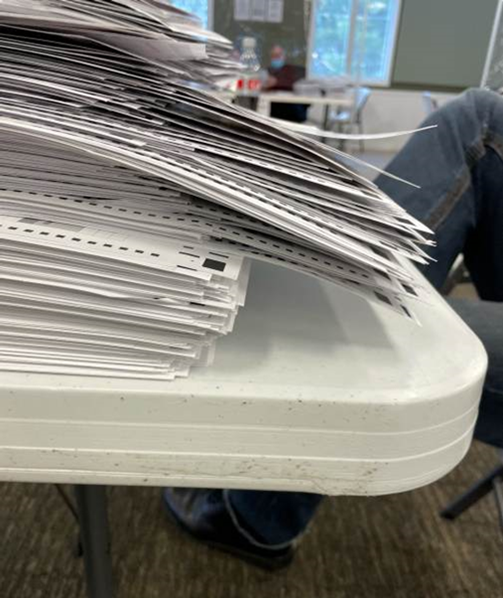By Patrick Colbeck
Many elected and election officials respond to allegations of election fraud with the narrative “just count the ballots”. So, can we determine the integrity of any election by just counting the ballots? No.
If you were given 100 one hundred dollar bills does that mean that you have $10,000? What would happen if you were to deposit those one hundred dollar bills in a bank? They would examine a sample of them to determine whether or not they were counterfeit. Only authenticated bills would be deposited into your account. If counterfeit bills were found, an investigation would likely ensue.

Why should it be any different for ballots than it is for hundred dollar bills?
Counterfeit Ballots
How do you determine if a ballot is counterfeit?

Some states specify that ballots must be printed on paper featuring security measures similar to our currency. If a ballot is found which does not conform to the specifications of these secure ballots, it is likely counterfeit.
Does that mean that any ballot which is printed on secure ballot paper is genuine? No.
How do you determine if a ballot printed on secure ballot paper is genuine?
You need to follow the chain of custody for the ballot all the way to the voter who cast the ballot and validate the following:
- The ballot was secured between the time the voter cast their votes on the ballot and the time it was counted
- The voter is eligible to vote
- The eligible voter is the one who cast that particular ballot
Let’s look into each of these items.
Item 1: Ballot Chain of Custody
How do you validate the ballot was secured?
You ensure there is a verifiable chain of custody for every transfer of the ballot.
What are examples of lawful ballot transfers?
- Voter deposits ballot in drop box
- Voter deposits ballot in mail
- Voter deposits ballot at clerk’s office
- Voter hands off ballot to an authorized assistant who deposits at drop box or clerk’s office
- Poll worker transfers ballot from drop box to clerk’s office
- US Post Office transfers ballots from mail box to clerk’s office
- Poll worker transfers ballot from clerk’s office to precinct or AV counting board
- Poll worker transfers ballot from precinct or AV counting board to secure storage
In order to ensure that each of these transfers is lawful, every data transfer downstream of direct voter action needs to be accompanied by chain of custody verification.
The documentary 2000 Mules provided evidence of ballot trafficking in battleground states during the 2020 election which appears to be unlawful.
Item 2: Eligible Voter
How do you determine if a voter is eligible to vote?
The primary criteria pertains to:
- U.S. Citizen
- 18 years old
- Resident of jurisdiction where vote is cast
Each state has slight variations on residency requirements which can get quite complicated when it comes to military ballots and Americans living in other countries.
As a condition for the receipt of funding under the 2002 Help America Vote Act, states created a single, consolidated statewide voter registration database containing a list of all of the eligible voters in a given state. Theoretically, if a person is listed in the statewide voter registration file, they are an eligible voter.
Why the disclaimer “theoretically”? Before one can be certain that an individual listed in the statewide voter registration is indeed an eligible voter, the integrity of the statewide voter registration database must be validated. Does it contain dead voters or voters which have moved outside of the state? Are the voters in the database even real people. A 2022 Michigan Auditor General attempted to assuage concerns over the integrity of the Michigan Qualified Voter File. They were unsuccessful. See the RELATED CONTENT section for more information.
Item 3: Eligible Voter Voted
Once we have validated that an individual is indeed an eligible voter, how do we determine if they actually cast a given ballot? The simple answer is “we can’t”. We have secret ballots in America. Just before a ballot is cast, the stub containing the tracking ID tying a specific ballot to a specific voter is ripped off to preserve the anonymity of the voter. This is a good policy to have in the cancel culture era in which we live, but it does impede investigations into election integrity.
Having said that, we do have ways to determine if the ballots cast correspond to eligible voters. We look at the aggregate number of voters casting a ballot in a given precinct and compare that number to the number of ballots cast in that precinct. If the number of voters who cast ballots does not equal the number of ballots cast, then the precinct is said to be “out of balance”. During the 2020 election, 71% of the AV Counting Boards in Detroit were “out of balance”. If a precinct is “out of balance” without any rational explanation, the votes in a given precinct are not subject to recount under Michigan law putting the final nail in the coffin for the “just count the ballots” narrative.
CONCLUSION:
Be wary of anyone who asserts that the integrity of any election can be determined by “just counting the ballots”. Either they don’t understand how elections can be subverted or they are complicit with the subversion. Ultimately, only a full forensic audit of the entire election record chain of custody can determine whether or not an election was conducted with integrity.
RELATED POSTS:
- Let’s Audit the MI Auditor General Report on Elections
- Michigan Mail-In Voting Issues
- Statewide Voter Registration File Audits: Very Insightful
- Are Ballot Image Audits Useful?
- Election Recounts: How Useful Are They?


